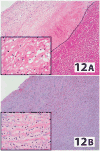Arterial pathology in canine mucopolysaccharidosis-I and response to therapy
- PMID: 21383673
- PMCID: PMC3084338
- DOI: 10.1038/labinvest.2011.7
Arterial pathology in canine mucopolysaccharidosis-I and response to therapy
Abstract
Mucopolysaccharidosis-I (MPS-I) is an inherited deficiency of α-L-iduronidase (IdU) that causes lysosomal accumulation of glycosaminoglycans (GAG) in a variety of parenchymal cell types and connective tissues. The fundamental link between genetic mutation and tissue GAG accumulation is clear, but relatively little attention has been given to the morphology or pathogenesis of associated lesions, particularly those affecting the vascular system. The terminal parietal branches of the abdominal aorta were examined from a colony of dogs homozygous (MPS-I affected) or heterozygous (unaffected carrier) for an IdU mutation that eliminated all enzyme activity, and in affected animals treated with human recombinant IdU. High-resolution computed tomography showed that vascular wall thickenings occurred in affected animals near branch points, and associated with low endothelial shear stress. Histologically these asymmetric 'plaques' entailed extensive intimal thickening with disruption of the internal elastic lamina, occluding more than 50% of the vascular lumen in some cases. Immunohistochemistry was used to show that areas of sclerosis contained foamy (GAG laden) macrophages, fibroblasts and smooth muscle cells, with loss of overlying endothelial basement membrane and claudin-5 expression. Lesions contained scattered cells expressing nuclear factor-κβ (p65), increased fibronectin and transforming growth factor β-1 signaling (with nuclear Smad3 accumulation) in comparison to unaffected vessels. Intimal lesion development and morphology was improved by intravenous recombinant enzyme treatment, particularly with immune tolerance to this exogenous protein. The progressive sclerotic vasculopathy of MPS-I shares some morphological and molecular similarities to atherosclerosis, including formation in areas of low shear stress near branch points, and can be reduced or inhibited by intravenous administration of recombinant IdU.
Conflict of interest statement
Conflict of interest: none declared.
Figures












References
-
- Neufeld EF, Muenzer J. The Mucopolysaccharidoses. In: Scriver CR, Beaudet AL, Valle D, Sly WS, editors. The Metabolic and Molecular Bases of Inherited Diseases. McGraw-Hill Professional; 2001. pp. 3421–3452.
-
- Kakkis ED, Muenzer J, Tiller GE, et al. Enzyme-replacement therapy in mucopolysaccharidosis I. N Engl J Med. 2001;344:182–188. - PubMed
-
- Muenzer J, Wraith JE, Clarke LA. Mucopolysaccharidosis I: management and treatment guidelines. Pediatrics. 2009;123:19–29. - PubMed

